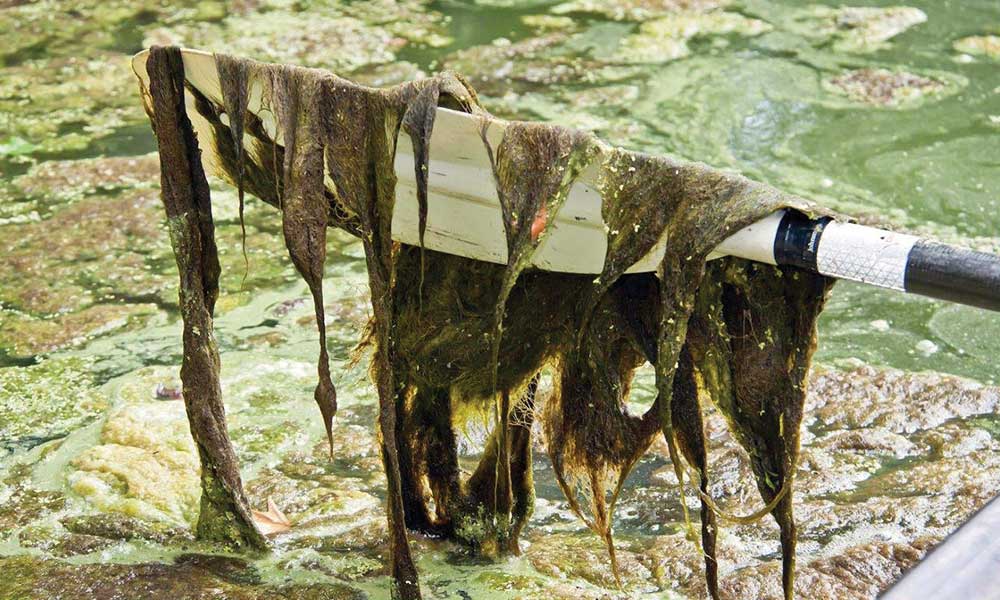Water Hazard: Reimage. Reinvent. Rebuild.


Diversified Waterscapes filamentous with lyngbya
You have a body of water. Some call it a lake, some call it a pond and some call it a pain. When you have a problem, you call a lake maintenance company to fix it. Sounds about right. This is considered reactive maintenance and while it will solve apparent problems, it does nothing to prevent time-consuming and potentially expensive situations from erupting in the first place. It’s the old question of defense versus offense.
Ponds and lakes are complex features. They are not merely large swimming pools that you can get by skimming the surface every so often. A basic understanding of water biology and aquatic ecosystems goes a long way in understanding and caring for them.
THE DO-RE-MI’S OF WATERSCAPES
In nature, balance is all-important. The amounts of elements entering a water system have to be in proportion to the amounts going out, or being used and released by the living organisms that call that system home. Clarity, equal nourishment, definitive boundaries wherein each part flourishes in proper proportion—these are the differences between a garden and a jungle. When one life form begins to dominate an ecosystem, the balance is destroyed and destruction follows. The task for anyone managing an aquatic environment is to attain and preserve balance. This means controlling not only harmful but all substances and organisms, and counteracting destructive processes.
To no one’s surprise, those processes are often man-induced. In fact, many of the products that serve us so well on land are the very ones that cause problems in our water environments. A prime example is the array of fertilizers at our disposal. These almost always contain high levels of nitrogen and phosphorous, chemicals that enrich land plants and stimulate healthy turf growth. But when they accumulate in runoff water, either as a result of poor irrigation, rainfall, or over-watering, they cause a huge imbalance in the nearby body of water. The result will almost inevitably be an infestation of algae and aquatic weeds.
Related: Body of Water, or Headache
Below are some common issues that, if untreated or improperly handled, can very quickly get out of hand.
Pickle Water
The pH level is a measure of how “acidic” or “basic” the water may be and is ranked on a scale of 1 to 14 with 7 being neutral (balanced). Low numbers represent acids while high numbers indicate alkaline or salt solutions. Evaporation, field run-off, salts, and minerals all affect the pH. Water circulation, aeration, and the measured addition of certain chemicals can restore a pond or stream to its proper pH. A knowledgeable professional who knows what he’s doing can make these assessments and apply the cure quickly.
Good Poison
Natural pesticides are good at eliminating pests and bacteria; however, too much of anything is never a good thing. Over-spraying may foul up the entire ecosystem. Stronger pesticides have the potency not only to do away with unwanted pests but, if used in high amounts, can threaten fish and wildlife as well. Good alternatives to manufactured pesticides are Enzymes, Beneficial Bacteria, and Colorants. Whatever you decide to go with, it’s always better to have someone on your side who can view the situation with the keen eye of professional experience.
Paint-Brush Water
Most algae are actually harmless and, in small amounts, an important presence in water ecosystems. But when there is an aquatic surplus of nutrients, or when eutrophication (nutrient enrichment) occurs, algae invade the whole area. Algae bloom cloud the water, giving it a dirty, turbid appearance and the smell of rotting garbage. Besides cutting off the photosynthetic process of other plants, algae suck up oxygen when cells die and certain kinds release toxins—making them potentially fatal to plants, fish, and wildlife.
Related: Copper & Algaecides: Making Informed Decisions
Organic Debris
Organisms and debris, such as tree leaves and grass clippings, very easily accumulate on the bottom and sides of an aquatic system. As they decompose, they become food for other organisms, wanted and unwanted. In no time at all, your waterscape may become clogged with excess plant life, not to mention bacteria and fungi colonies. All of this then becomes food for yet more organisms. Only vigorous intervention can interrupt this vicious cycle.
Related: Don’t Tell Me Muck Removal Isn’t Sexy!
Stagnation
It’s deadly, for humanity and nature. Study and smell any stagnant pool of water and you’ll find positive proof of it. Circulation is essential to a healthy aquatic environment. It aerates the water, inhibits unwanted plant growth, and prevents your pond from becoming a breeding ground for mosquitoes and other pests.
Reclaimed Water
If you’ve got it, you know. Reclaimed water is overloaded with salts and nutrients and has an unmistakable strange odor and a pea-green, soupy color.
OFFENSE APPROACH
Because so much natural science is involved, it may sound as though what you really need is a biologist or even a chemist to look over your water system. But the truth is that both of these will fall short in the long run. A biologist is not usually an expert who can identify the specific needs required by each unique aquatic ecosystem. He or She may not specialize in blueprints, planning, or mechanical engineering, nor can they make wise recommendations to ensure the water systems’ longevity.
A Certified Lake Manager (CLM), on the other hand, can do all those things and more! They have undergone a rigorous training program and curriculum specific to lake and watershed management relating to financial, regulatory, and even social aspects. CLMs have the skill set necessary to manage and maintain large water bodies and are qualified to make proper assessments and prescribe actions to improve or protect the condition of the entire water system. And if they have been in the business long enough, they have had multiple years of experience and many opportunities to expand their knowledge, because a true professional is always pushing the boundaries of what they know, maximizing their ability and expertise.
Related: Taking an Offensive Position in Your Lake Maintenance Game
Hopefully, now, you see there’s much more to water features than a trip to the local fish store and tool shed. In fact, so much is involved, scientifically, biologically, mechanically, and environmentally, that it can be overwhelming. But it doesn’t have to be. For the best results, lakes, streams, and ponds require proactive maintenance: a preventative approach that works in conjunction with the existing ecosystem in order to prevent overbearing and costly situations from developing down the road.
Lake maintenance companies with a reactive approach hire personnel who can only—react. All action is deferred until after the problem has erupted, not before. By then the water’s surface may be a carpet of strange, slimy globs of green stuff. Huge mats of bizarre grass may start floating up from the bottom, and the water becomes weirdly discolored. If that happens, it won’t be much longer before pumps cease functioning or start groaning and choking. Waterfalls might slow to a trickle. One problem after another is sure to arise. Obviously, the thing to do is call, shout, and scream for a maintenance person, but realize that you are treating the symptoms. Not the cause or causes. And unless those are dealt with, the problems will be back.
On the other hand, a company with a proactive approach trains its personnel not only to solve problematic issues but also on how to prevent them. Proactive maintenance personnel is forward thinkers. They understand the root of problems and are able to eliminate costly situations before they occur or become visible.
For example, lake maintenance professionals monitor and measure the growth of aquatic plants, much like Arborists and Pest Control Advisors (PCA’s), and are aware of seasonal changes and developments. Aquatic plants require careful watch even during the dormant winter months, otherwise, an expected summer bloom may turn into a tangled nightmare. Water plants have a tendency to grow wild and out of control, creating yet another need for timely and expensive reactive restoration. But rather than reaching for the shears, call a proactive professional who will figure out what caused the overgrowth. A possibility may be the unseen accumulation of sludge accumulating at the base of your aquatic ecosystem. Instead of just cutting away at the overgrowth, a proactive professional will treat the sludge.
Aquatic ecosystems encompass more fields than biology alone; they almost always require mechanical knowledge as well. Proactive maintenance companies train their employees in hydraulics, aeration, water movement, and the workings of all the equipment found in the system. An underground Pump Vault will consist of electrical panels, pumps, fans, and lighting systems. Equipment malfunctions can be incredibly costly. A licensed professional with confined space training certifications is qualified to regularly check that the wiring and equipment in the Pump Vault are functioning safely and efficiently.
Again, if you know the root cause of the problem, workable solutions fall into place. For example, if a motor in the pump vault is running hot, the reason can be determined and the customer informed of the corrective action before more drastic—and expensive—measures become necessary. The issue may be resolved with the replacement of a $400 component. However, if left to itself, the pump may become so damaged that it needs to be replaced—a potential $7000 cost or more to the customer. It’s all a matter of timing, and a proactive professional has excellent timing.
The water management professional also has a large arsenal of tools to keep your watery paradise looking like, well, a paradise. Here are a few of them:
Filters
These remove suspended particles, enhancing clarity but also discouraging plant growth. Obviously, they only work when the pump is running! Even in today’s frugal, economic climate, 12 hours a day should be the minimum. Remember, filters must be changed regularly.
Aerators
These can include fountains and should be strong enough and strategically placed to ensure full effectiveness.
Defoamers
Nothing spoils the aesthetics of a water feature like unsightly foam, which typically is caused by soap and/or dead organic matter. A good defoamer does the trick, but its effectiveness is reduced if you don’t manage the source of the cause.
Flocculent/clarifiers
These agents work like magnets, latching onto floating contaminants such as silt, algae, dust and dead organic matter. The aggregated particles eventually become so heavy that they fall to the bottom.
pH balancers
These work alongside other additives to ensure their effectiveness in slowing down biological contamination.
Enzymes
Let’s say you’ve addressed the issues of aeration and filtration, yet you still have an algae problem. You need to apply a chemical solution. The right enzymes, carefully chosen and monitored, can help tremendously in this process.
Dyes
Imagine you have a TV crew coming to film your golf tournament tomorrow—and the once-beautiful pond is a scummy brown! Before screaming at the groundskeeper, rush to the store and purchase a dye to perk the water up for the cameras. You may not know it, but the dye will inadvertently benefit the water’s health, because the coloring will limit the amount of sunlight reaching below the surface, discouraging unwanted plant growth.
IN CONCLUSION
What’s cheap now is expensive later. That’s why it is essential to know as much as possible about your lake maintenance company beforehand. How long have they been in business? Are they properly licensed to apply pesticides to your water? Do they know the laws for dumping water down the street drain?
These are just a few of the questions they need to answer because if they make a mistake, you will be liable for the damage. Not to mention the stress and regret. Any maintenance company can fix problems; what you need and want is a company that can prevent them.
5 QUICK QUESTIONS TO ASK YOUR CONTRACTOR
- Do you make the products that you use? Are the products branded and certified?
- What is the difference between aerators, fountains, and biofilters?
- Liability: Do your employees know how to swim, and wear the proper safety gear or will they drown on my property?
- If I want the natural approach, will it cost more, and why? Explain to me what natural means!
- Is it important to do preventive care and will that extra cost save me money in the future?
Patrick Simmsgeiger, CLM President of DWI, a lake management company, Manufacturer of F-30 Algae Control, Distributor, Service Provider & Aquatic Speaker With over 40 Years of Experience in the Field contactus@dwiwater.com
Recent Posts
Memphis Country Club: A Golfer’s Study in Precision and Tradition
If you have ever teed it up at Memphis Country Club, you know this isn’t…
Foley Company attains GCSAA Silver Partner Status
Foley Company, a leader in turf equipment innovation and technology, affirms its support of the…
Harrell’s continues longstanding support of the GCSAA Foundation
Harrell’s LLC, a leading distributor of customized agronomic products for turfgrass since 1941, has donated…
City of Orlando Announces New State-of-the-Art Driving Range at Dubsdread Golf Course
The City of Orlando is excited to announce the construction of a brand-new, state-of-the-art driving…
Discover Puerto Rico for Great Golf Trips and After-Round Activities, Amenities
Golfers cannot live by the game alone which is why Puerto Rico provides the perfect…
Q&A with a Multi-talented Golf Course Architect – Part 2: Making the Rounds – Installment 39
This column features recollections of the author’s 37 years as a golf writer. These installments…


